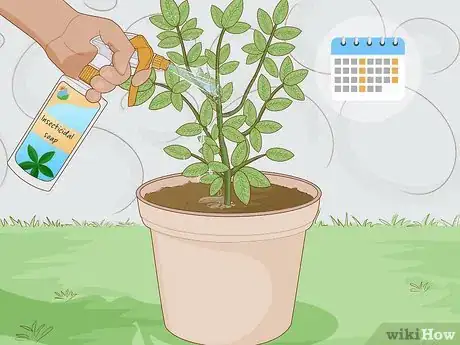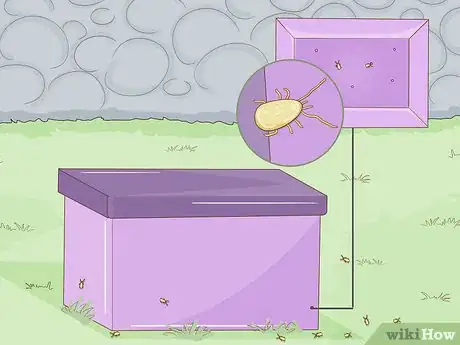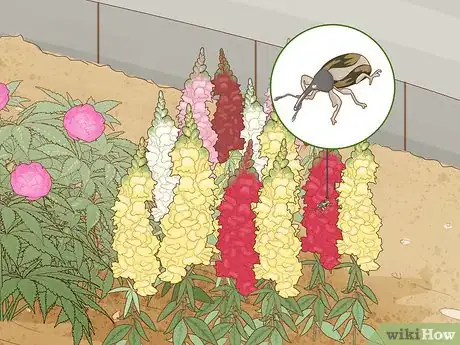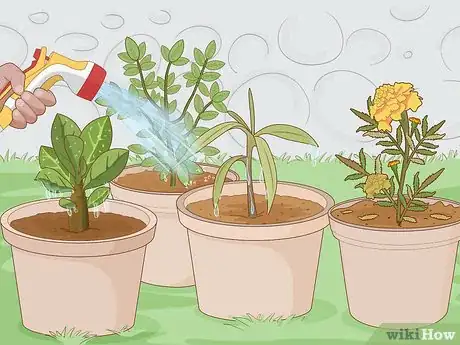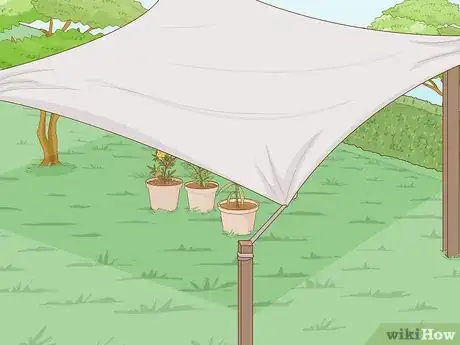This article was co-authored by Chikezie Onyianta and by wikiHow staff writer, Eric McClure. Chikezie Onyianta is a Pest Control Specialist and the Owner of EcoFusion Pest Control, serving communities in New Jersey, Pennsylvania, and New York. With over 5 years of experience, he specializes in pest control in both residential and commercial spaces. A graduate of Essex County College, Chikezie and EcoFusion assist in rodent, roach, and ant pest control as well as bed bug services.
There are 7 references cited in this article, which can be found at the bottom of the page.
This article has been viewed 17,262 times.
It's important to protect your houseplants and garden from insects like spider mites that will feed on your plants and cause them damage. Luckily, we have tons of tips to help you fight these pests so you can keep your plants healthy!
Steps
Using a Chemical Killer
-
1Apply miticide to infested plants to effectively kill mites and prevent nesting. There are a variety of mite-specific insecticides on the market. These insecticides are called miticides, and they can be purchased online or in a local gardening supplies store. While every brand is different, using a miticide usually involves spraying your plants with the miticide daily to kill existing colonies.[1] [2]
- Different brands of miticide will have different instructions printed on the label. Follow your specific brand’s instructions as closely as you can to deal with mites.
- If you have an active mite infestation, look for a miticide that kills on contact and prevents future nests from hatching.
- There are preventative miticides that you can spray in your garden to prevent mites from showing up.
-
2Wash plants in an insecticidal soap if the miticide proves ineffective. Purchase an insecticidal soap with a wide-spray nozzle and apply it to any mite-infested plants. Follow the specific directions on your soap’s label to apply it in the proper intervals to completely rid your plants of mites. Typically, you’ll need to apply the soap once every 2-4 days to ensure that all mites are exposed to the soap.[3]
- Avoid applying insecticidal soap to sensitive plants.
Tip: If miticide doesn’t work, you may have a unique or uncommon species of mite hanging out around your plants. Certain miticides only work with a select group of mite species (usually spider mites, which are the most common).
Advertisement -
3Use a dormant oil in the winter to kill nesting adults. Dormant oil is an organic oil made out of either petroleum or cottonseed. Apply dormant oil to your mite-infested plants once the weather starts to get colder by spraying or brushing each section of your plant with your oil. This will suffocate any mites that may try to overwinter in your garden and will naturally destroy a mite infestation over the course of a season.
- Dormant oil works by coating your plants in a protective oil which gets on the mites when they get on your plants.
- Dormant oil can kill or damage trees if you apply it after new leaves have just grown.
-
4Apply a summer oil during the growing season to kill active infestations. Summer oil, which is also known as horticultural oil, is a lightweight version of dormant oil that doesn’t damage plants while they’re growing. You can apply summer oil during the growing season by spraying it over your plants. Summer oil will kill existing mites while preventing new mites from hatching or feeding in your garden.[4]
- If your plants turn yellow after spraying them with summer oil, stop using it until the plant’s color returns.
- You may see neem oil on the shelf next to dormant and summer oil at your local gardening store. While neem oil is an excellent organic alternative to many chemical pesticides, it is generally ineffective at combatting mites.
Introducing a Natural Predator
-
1Buy and release some ladybugs to keep mites and other pests under control. Purchase 250-1,000 ladybugs online or from a pest control store. Ladybugs feed on mites, and will hang out in your garden to eat them for as long as the mites are eating your plants. Release your ladybugs later in the day to increase the odds that your ladybugs spend the night in your garden.[5]
- Leave your ladybugs in the refrigerator for 20-45 minutes before you release them to calm them down and reduce the chance that they fly away after they’re released.
- Ladybugs will also eat other pests, like aphids. This makes ladybugs a good choice if you want to control all the pests in your garden.
Warning: Ladybugs are a bad solution if you’re trying to solve a pest problem in the last month of the growing season, since they don’t live as long when it gets cooler out.
-
2Purchase some predatory mites and let them loose in your garden to only remove mites. You can purchase predatory mites online or from a pest control company. Buy 1,000-1,500 predatory mites and put their box in your garden. Punch a few dozen 1–2 in (2.5–5.1 cm) holes near the bottom of the box with a pencil or small knife and give the predatory mites time to wander out and start hunting. Predatory mites feed on spider mites and will eat eggs, nymphs, and adults.[6]
- Predator mites will kill spider mites, russet mites, and broad mites. There are a few other species that they won’t feed on though.
- Predator mites generally won’t attack other pests. This makes them a good choice if you’re only trying to get rid of mites.
- You can tell the difference between spider mites and predatory mites by looking at the mite’s body. If it is shiny and not spotted, it is a predatory mite.
-
3Attract pirate bugs to your garden by planting flowering plants if you aren’t in a hurry. Pirate bugs are tiny insects that appear early in the spring. They are fond of eating and hunting plant mites, and can be attracted to your garden by planting some flowering plants. Any flowering plant, like marigolds, fennel, or alfalfa, can attract pirate bugs to your garden.
- Trying to attract pirate bugs is a good idea if you planned on doing some flower-planting anyway. It can take the tiny predators a while to show up though, so this is not a good idea if you have a big mite problem.
- Pirate bugs will bite humans if you mess with them, but they aren’t dangerous.
- Pirate bugs are smaller than 1⁄5 inch (0.51 cm) and have an oval-shaped body. They are usually black or purple and have wings.
Preventing Mites
-
1Water your plants regularly, especially during dry periods. Plant mites flourish in dry conditions and struggle in wet environments. To avoid attracting mites, water your plants every morning and keep them misted throughout the day during particularly dry periods. Watering your plants will also deter an existing infestation from sticking around for too long.[7]
- When a plant is wet, it is hard for plant mites to adequately feed on it.
- Different plants have different water needs. Do not water a plant every day if it requires drier soil.
- Rinse stronger plants with a firm stream of water. This will knock mites off and remove their webbing.
- Mist plants with a spray bottle to keep them humid in the afternoon.
-
2Remove dead plant leaves and dry debris from the soil around plants. Mites tend to live underneath dead plant leaves and stems near the soil. If you consistently keep the soil in your pot or garden clear of dead leaves and debris, mites are less likely to nest. In the colder months where mites may be overwintering in your garden, removing the dead plant leaves and dry debris will remove their hard-to-see nests and eggs while they’re dormant.[8]
- Mites deplete resources from plants and cause their leaves or petals to dry up faster than they normally would. If you find yourself continuously picking up dead leaves every day, it may be a sign that you need to step up to a chemical insecticide.
-
3Isolate infested plants to prevent mites from spreading to other plants. Mites cannot fly, but they are avid jumpers when it’s windy. To prevent a mite infestation from spreading, remove infested plants and place them in an isolated part of your garden or home. Select a location where there are no other plants within 10–15 feet (3.0–4.6 m) of your affected plant to prevent a colony from growing and your infestation from spreading.[9]
- If you can, rearrange your unaffected plants into clusters with as little space between them as possible. This will trap humidity in the area around the bottom of your plants and keep mites from wanting to make your garden or planted pot home.
-
4Keep plants out of the sun in the afternoon. If you have a houseplant, move it away from any windows in the afternoon. If you have a garden, cover your plants in partial shade by setting up a canopy or umbrella. The less light that your plants have in the afternoon, the less likely mites are to show up or stick around.[10]
- Mites are naturally attracted to sunny areas, especially after noon when they’re most active. Keeping your plants in the shade can deter mites from sticking around.
-
5Place a humidifier next to indoor plants. During dry spells, place a humidifier next to houseplants to keep their soil moist and their leaves humid. This will keep mites from hanging out around your plants and will make it hard for overwintering nests to hatch.[11]
- When a colony of mites is overwintering, they are dormant and you may not see any mite activity. Continue treating, watering, and shading affected plants throughout the cold season even if you think the mites are gone.
Tip: It’s impractical and not as helpful to set up a humidifier in a garden. To keep outdoor plants moist, simply water them daily and mist them as needed to keep them moist.
References
- ↑ Chikezie Onyianta. Pest Control Specialist. Expert Interview. 1 April 2021.
- ↑ https://gpnmag.com/article/mite-b-gone-understanding-miticides/
- ↑ https://entomology.ca.uky.edu/ef406
- ↑ https://www.mcall.com/business/real-estate/mc-garden-spider-mites-garden-rid-0830-20140829-story.html
- ↑ https://www.sciencedaily.com/releases/2009/11/091102171613.htm
- ↑ https://extension.umd.edu/hgic/topics/predatory-mites
- ↑ https://www.mcall.com/business/real-estate/mc-garden-spider-mites-garden-rid-0830-20140829-story.html
- ↑ https://www.mcall.com/business/real-estate/mc-garden-spider-mites-garden-rid-0830-20140829-story.html
- ↑ https://entomology.ca.uky.edu/ef406


